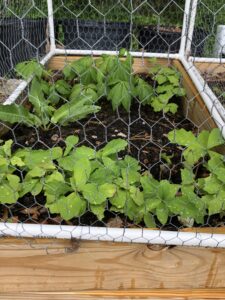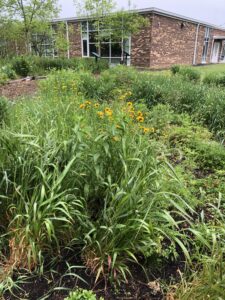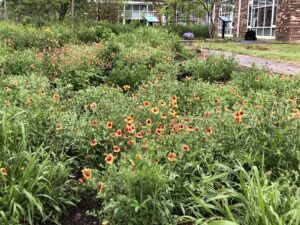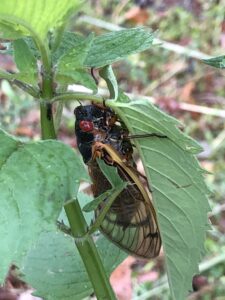NHBA Partners with Durham Public Schools to Plant Native Plants
Author: Julie d’Ablaing, NHBA Bird-Friendly Team
Published May 27, 2024
New Hope Bird Alliance volunteers such as Julie d’Ablaing have been reaching out to Durham Public Schools (DPS) to introduce and encourage growing native trees. This blog is about two of those projects that are ongoing as of April 2024: growing native trees, and replacing turf with pollinating plants. Please let us know if you are interested in initiating or supporting similar projects.
Pilot Project: Durham school students to grow hundreds of native tree seedlings for their community
NHBA has been awarded a generous grant from the Croasdaile Garden Club to put air pruning boxes into Durham schools as a pilot program. A total of seven boxes have been installed into four Durham school sites. These four sites, two in north Durham and two in south Durham, include students from elementary to high school. As the trees grow and the experiences are shared in this pilot project, we hope that the students and teachers in new sites will request to be a part of the program.
Project Pando Provides Inspiration
Julie was inspired by Project Pando, which has designed a simple air pruning box in which to grow up to 100 tree seedlings. Julie reached out to Durham Public Schools (DPS) with a proposal to install these boxes for student science education across grades. Science curriculum staff adopted a pilot project in which students collect seeds from native trees, plant them, and watch them grow. This project supports plant and ecology curriculum areas across student age ranges: introducing the live plant materials, studying growth, and considering the importance of the native trees to the environment. The project can also introduce students to possible career paths.
Students are growing large and small trees and shrubs, all native, with seed sourced from our local Triangle area. They will learn that local native plants are important, as these plants evolved within our Piedmont ecosystems, which makes them better survivors, feeding both human and wildlife populations. At harvest, seedlings will be offered to the local school community, planted on site, and if there is still excess, they will be offered back to Project Pando for wider distribution to the public.
Lyons Farm Elementary School
Lyons Farm Elementary School has a single box, located in their sunny deer fenced garden area. With an active gardening curriculum and native plantings around the school, Lyons Farm teachers are particularly interested in growing Common Pawpaw (Asmina triloba) and native persimmon trees.
Lowe’s Grove Middle School
Lowe’s Grove Middle School is an agricultural magnet school with a Farm to Market stand. This provides a way for students to share the trees they grow with their community.
Lowe’s Grove installed two air pruning boxes, tucked into the part shade of a tree line. Planted in the fall of 2023, the seedlings emerged in spring 2024.
Northern High School
Northern High School has received two boxes, where the science and horticulture teachers are keen to have students grow trees and shrubs to restore habitat on their school site after the new build construction.
The Hub Farm
The Hub Farm is a project of Durham Public Schools. Its mission is to engage the DPS community in meaningful outdoor experiences. The farm has an established gardening community and is a year-round site for school field trips.

From left to right: Julie d’Ablaing; Susan Antle, Croasdaile Garden Club; and Geoff Seelen, Hub Farm.
Participating in the pilot project supports its community outreach. The seven native tree species the Hub Farm is growing include Overcup Oak (Quercus lyrata), which was chosen as it has kid friendly, “quirky” acorns where the cup nearly swallows the acorn!
Removing Turf and Creating Pollinator Habitat
As a new member of NHBA’s Bird-Friendly Team and its recorder, Julie listened to the advice that the team’s plant experts gave homeowners who wished to have “wildflower meadows” in their sunny home landscapes. She was sufficiently intrigued by the two different sources and seed mixes recommended for Durham landscapes—“Mellow Marsh” and “Roundstone”—that she requested to test them out on a local school site.
In the summer of 2013, volunteers covered a 1600-sq. ft. area of sunny, mowed but otherwise unused turf at Lowe’s Grove Middle School with cardboard, then a layer of soil, and then two native plant seed mixes funded by a New Hope Bird Alliance grant.
Nine months later, the cool season grasses, dominant grass content of the Mellow Marsh mix, are flowering among early spring flowers such as Lanceleaf coreopsis (Coreopsis lancelolata). The Roundstone mix is currently dominated by wildflowers, particularly Gaillaridia; the dominant warm season grasses will germinate later in the year.
Students are making “casual” observations of insects and birds for an iNaturalist project, such as a Riley’s cicada (Magicicada tredecium).
It will be interesting to continue to monitor these two seed mixes as they mature.
« Back to All Press


